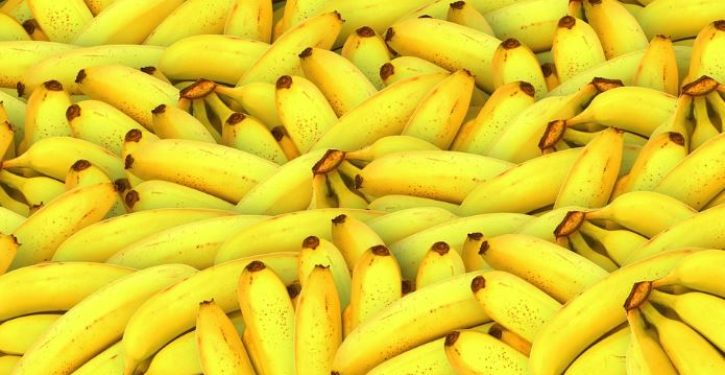
Scientists in Uganda have developed a genetically modified banana that could save thousands of children who die every year from vitamin A deficiency in that poor African nation. But regulatory and cultural obstacles may prevent it from doing so.
Vitamin A deficiency afflicts around 200 million preschool-age children across the globe, and can cause blindness and “immune system failure, sometimes resulting in death. UNICEF has identified Uganda as one of the priority countries for its vitamin A supplementation program.”
This “super banana,” known as Banana21, was developed through two decades of research. “Scientists combined a type of banana called the Asupina, which is rich in provitamin A and native to New Guinea, with other types of bananas that are easier to grow and considered better tasting,” notes a web site devoted to innovation:
Unfortunately, the Ugandan government has yet to approve the sale of genetically modified foods. The government first passed legislation in 2017 regulating biosafety, but the legislation is being revised, and Ugandan President Yoweri Museveni has yet to sign it into law.
Wilberforce Tushemereirwe, the director of the lab where the banana was developed, blamed European nongovernmental organizations for spreading doubts about genetically modified food.
“It’s only fears of people who have more than enough to eat, and that fear is being transmitted to people who have no food, who are dying of starvation,” he said. “I feel very disappointed and frustrated about the slow political process that is listening more to a small minority of anti-GMO Ugandans who are against the release of provitamin A bananas and not to the science that would have saved children’s lives.”
There is also the question of whether Banana21, which has an orange tint due to its high concentration of vitamin A, will be accepted by Ugandans. As bananas are already an incredibly important and popular food in Uganda, a new, different version from what people are used to may turn off potential customers.
Bananas are not the only genetically modified food that could gain regulatory approval — in the United States, a genetically modified corn designed to withstand harsh weather was recently approved for commercial consumption.
Just because the banana is good for people does not mean it will be culturally accepted. For generations, peasants in many European countries viewed potatoes as unhealthy –thinking they caused diseases if consumed — or that they were fit only for animals.
Just because it is safe and healthy does not mean it will be accepted by regulators, either. Bureaucratic agencies delay for years the distribution of genetically-enhanced crops and foods that are obviously safe. It took 20 years for genetically-enhanced salmon to be approved by the FDA, even though the salmon is perfectly safe.
Government officials are often stupid when it comes to nutrition and food safety. In Reason magazine, Baylen Linnekin wrote about “the sickening nature of many food-safety regulations,” like the “poke and sniff” inspection method mandated by the U.S. Department of Agriculture “that likely resulted in USDA inspectors transmitting filth from diseased meat to fresh meat on a daily basis.” Government officials are often biased against nutritious foods and in favor of foods with little nutrition. A 2010 study funded by the National Institutes of Health encouraged parents to stock their refrigerators with apple sauce, even though apple sauce has basically no nutrition unless vitamins are artificially added to it, since much of the vitamin C in an apple is destroyed when it is processed into apple sauce. Meanwhile, the NIH warned against consuming potatoes, which are rich in vitamin C, potassium, and various minerals. Baked potatoes are healthy, although some of potatoes’ vitamin C is lost if you process them into french fries. Potatoes have much more vitamin C than bananas or apples. And they have more potassium than supposedly potassium-rich bananas. The federal government’s “Food Pyramid” encouraged consumption of empty carbohydrates rather than protein and other nutrients, fueling rising obesity and diabetes rates. From 2009-2017, the federal government banned the use of WIC money by low-income parents to buy white potatoes, while allowing the money to be used for many less nutritious foods.
In 2010, the Department of Health and Human Services spent $766,000 to help open an International House of Pancakes, even though IHOP has sugary entrees that could make someone obese. IHOP served two of Men’s Health Magazine’s 20 most unhealthy restaurant dishes. While warning about the dangers of eating fat, the Agriculture Department was simultaneously promoting greater consumption of fatty cheeses, reported the New York Times.
In backward times and nations, healthy foods needed to keep people alive may be banned. A classic example occurred more than two centuries ago, when regional parliaments banned consumption of the potato in much of France, leading to a short-lived national ban beginning in 1748. “Among the host of diseases the government mistakenly attributed to consumption of the tuber was leprosy.” This ban was particularly problematic because at the time, France was plagued by recurrent famines. French officials banned the potato despite the fact that it had been cultivated and consumed for generations in neighboring Germany, where the potato saved villagers from starvation at the end of the Thirty Years War that lasted from 1618 to 1648. Cultivating the potato would have generated more calories per acre than alternative crops, preventing countless children from dying of malnutrition.
Many 17th Century German villages that refused to cultivate the potato died out and became ghost towns due to mass starvation during the Thirty Years War, as marauding troops destroyed or confiscated above-ground crops such as wheat. Villages that grew the potato survived. Emulating those Germans, hungry Europeans finally began eating the potato. The result was that “for the first time since the Little Ice Age began, 300 years before, Europeans became healthier, were better fed, famines were averted, and populations began to rise again. For example, over the next 200 years, the Irish population tripled.”



